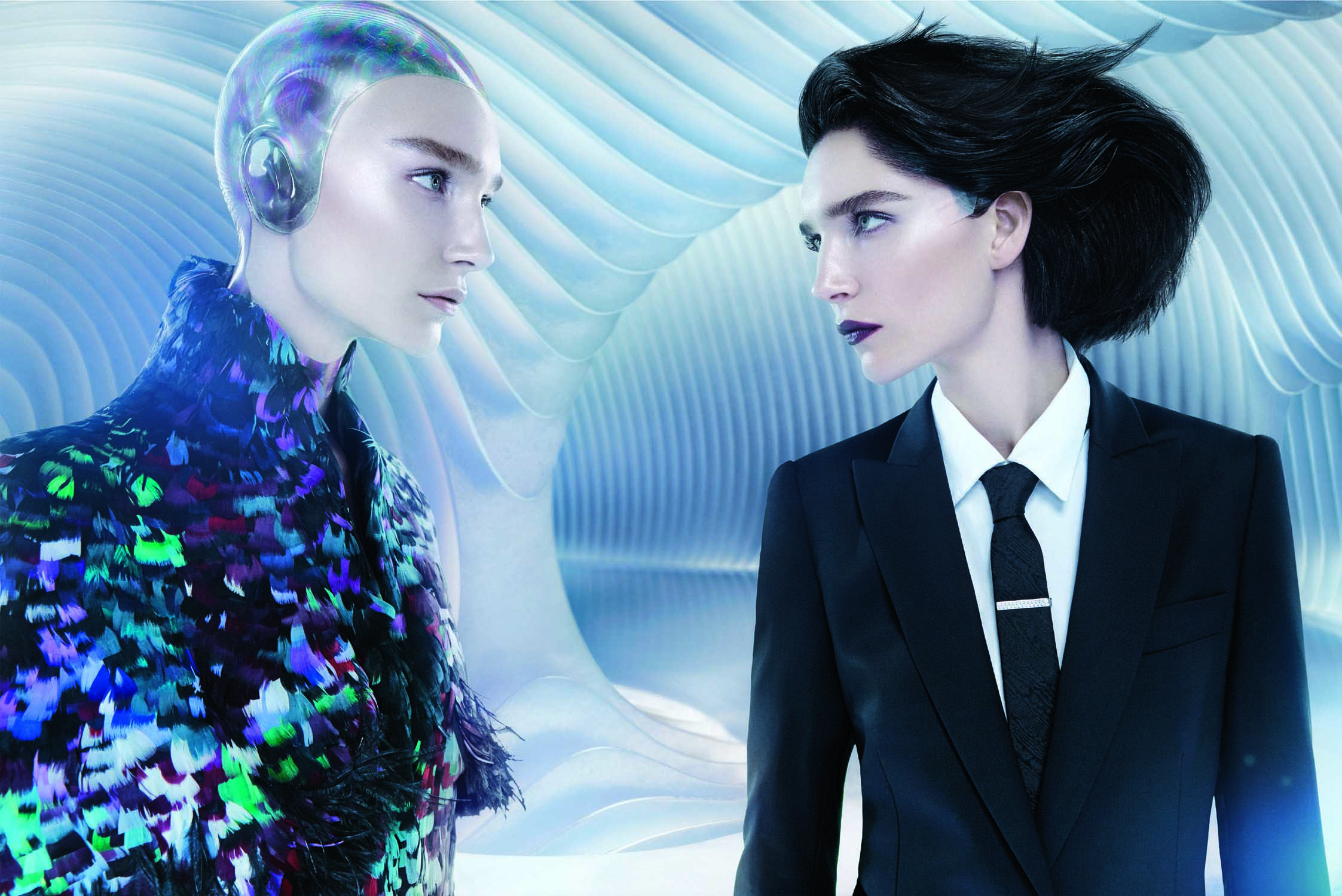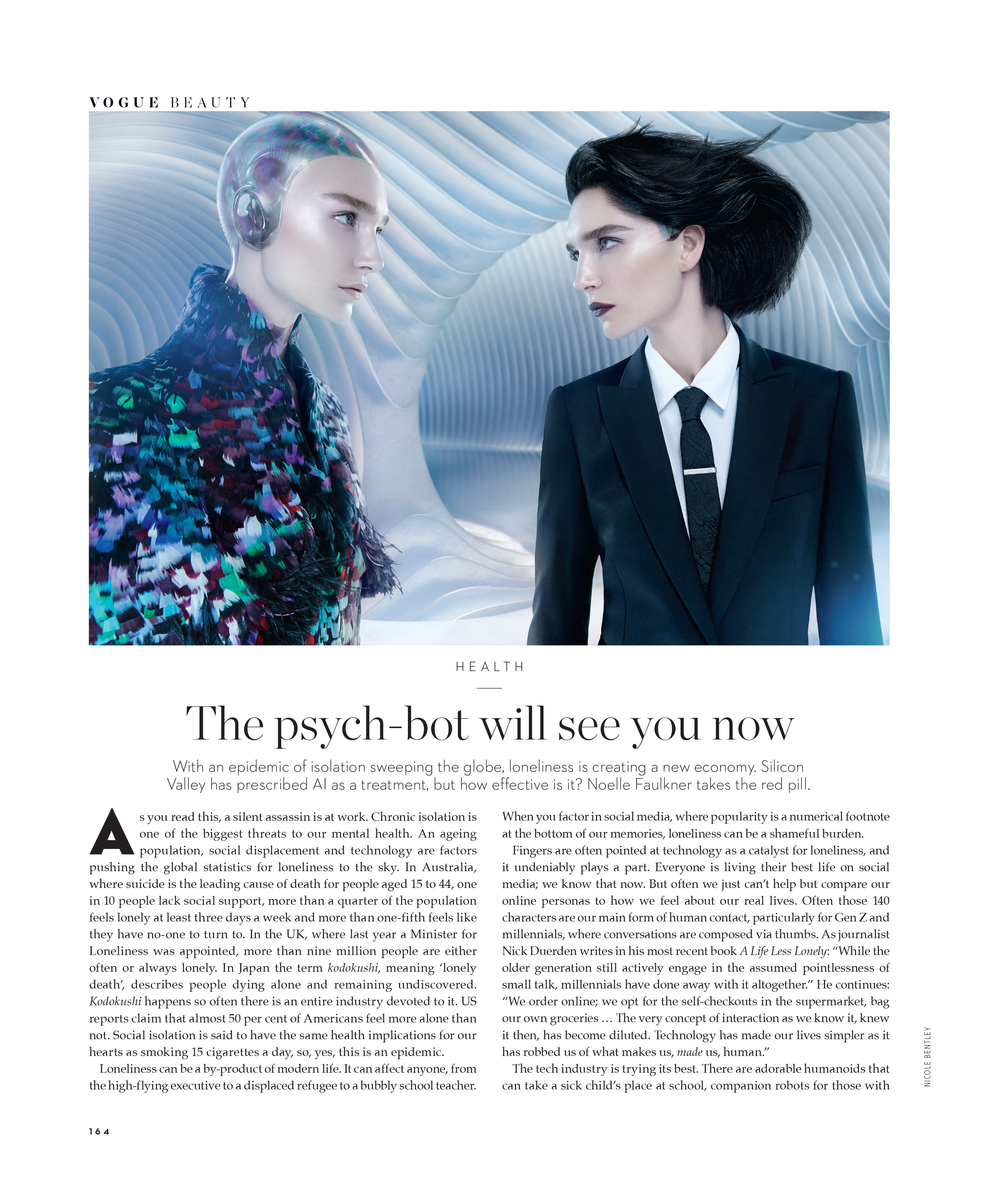
Vogue, March 2019 (PDF)
With an epidemic of isolation sweeping the globe, loneliness is creating a new economy. Silicon Valley has prescribed AI as a treatment, but how effective is it? Noelle Faulkner takes the red pill.
As you read this, a silent assassin is at work. Chronic isolation is one of the biggest threats to our mental health. An ageing population, social displacement and technology are factors pushing the global statistics for loneliness to the sky. In Australia, where suicide is the leading cause of death for people aged 15 to 44, one
in 10 people lack social support, more than a quarter of the population feels lonely at least three days a week and more than one-fifth feels like they have no-one to turn to. In the UK, where last year a Minister for Loneliness was appointed, more than nine million people are either often or always lonely. In Japan the term kodokushi, meaning ‘lonely death’, describes people dying alone and remaining undiscovered. Kodokushi happens so often there is an entire industry devoted to it. US reports claim that almost 50 per cent of Americans feel more alone than not. Social isolation is said to have the same health implications for our hearts as smoking 15 cigarettes a day, so, yes, this is an epidemic.
Loneliness can be a by-product of modern life. It can affect anyone, from the high-flying executive to a displaced refugee to a bubbly school teacher. When you factor in social media, where popularity is a numerical footnote at the bottom of our memories, loneliness can be a shameful burden.
Fingers are often pointed at technology as a catalyst for loneliness, and it undeniably plays a part. Everyone is living their best life on social media; we know that now. But often we just can’t help but compare our online personas to how we feel about our real lives. Often those 140 characters are our main form of human contact, particularly for Gen Z and millennials, where conversations are composed via thumbs. As journalist
Nick Duerden writes in his most recent book A Life Less Lonely: “While the older generation still actively engage in the assumed pointlessness of small talk, millennials have done away with it altogether.” He continues: “We order online; we opt for the self-checkouts in the supermarket, bag our own groceries … The very concept of interaction as we know it, knew it then, has become diluted. Technology has made our lives simpler as it has robbed us of what makes us, made us, human.”
The tech industry is trying its best. There are adorable humanoids that can take a sick child’s place at school, companion robots for those with disabilities, and a multitude of smart-home technologies that can help
the elderly. In fact, in January this year, the UK government announced it would be providing a number of ‘smart homes’ to elderly and disabled people, to aid them around the home and stay in touch with others. I’m inclined to disagree with Duerden – giving ouropposable thumbs the same agency as our tongues doesn’t make us less human, and emojis are a form of emotional expression. Texting gets a bad rap. It’s perceived as a cold, worthless form of communication because it’s non verbal. And yet research findings suggest the opposite. In 2015, a study by RTI International, Cornell University and LaSalle Hospital in Montreal showed that texting can help provide comfort and even supplement pain
medication during minor surgery. Compared with the act of playing an addictive game (in this case, Angry
Birds), researchers found that texting in-theatre,
particularly while conversing with a stranger about
positive things, actually reduced the need for painkillers.
“Although at first it seems counterintuitive that text
messaging with a stranger was more effective than with
a companion, it’s the content of the conversation that
makes the difference in reducing patients’ need for pain
relief during surgery,” said RTI digital media health
research scientist Dr Jamie Guillory. “This is significant,
as the physical presence of a social support companion is often not feasible during many minor surgical procedures.”This kind of research, combined with advancements in machine learning and natural language applications, is what has helped health
experts and Silicon Valley start-ups tap into the potential for chat-based therapy, which was actually invented in the 60s. Enter the psych-bots.
Take 7 Cups, for example, a peer-listening chat service, and Woebot, an AI-powered chatbot versed in cognitive behaviour therapy (CBT). While 7 Cups has an AI called Noni on staff, it gives you the option to anonymously confide in a real person or a therapist, anywhere and
anytime. It offers a shoulder, an ear or access to a professional. Woebot, on the other hand, aims to emulate a real-life interaction using natural language and CBT-based conversations. Woebot’s therapy is ongoing, too – it checks in daily and asks users to log their mood while offering bite-sized, friendly advice on a range of mental health topics. A psych-bot’s couch may be free and always open for business. Conversations are anonymous and they don’t judge. Patients don’t have to jump through any hoops, there’s no Medicare faff and when it comes to cutting through problems, that robotic level of pragmatism can be a benefit. Woebot has particularly been successful among people aged 18 to 28, with a Stanford School of Medicine trial showing the app significantly reduced symptoms of depression and anxiety in two weeks.
Of course, bots can’t replace real-life human interactions, especially when it comes to dealing with a crisis or long-term support (a cancer patient undergoing chemotherapy, for example). This is because AI struggles with memory specifics; it won’t remember your story. But what if it could? What if you could build a companion that learned everything about you, your environment, inner circle and emotions? What if you could combine AI with augmented reality technology to
‘design’ a companion? This isn’t fiction: this is the rabbit hole.
Searching for a robo-pal on the internet can send you down a weird and wildly twisty path. There are sexually charged chatbots, Amazon Alexa personality extensions and a very lucrative sexbot market. But scratch off the top layer of dirt and you’ll find technology to build your own Samantha from Spike Jonze’s movie Her or Joi from Blade Runner 2049
.
You’ve heard of the internet of things? What if you used that and turned the dials right up? Using crypto technology to pull information from all over, coders have found a way to create an AI programming language that can be entirely personalised. Using deep learning, the program can source data to a cluster of information known as a tangle. This could be anything that relates to you, from news to sports results, recipes, traffic reports and location information – whatever it needs to make up a picture. Your AI can learn everything about you and it could have the ability to connect to your car, your doorbell and your TV, and it might even get to know your friends using facial recognition. Throw in a pair of glasses with a camera or a VR headset, a Fitbit (to monitor your heart rate and emotion, so it learns what excites you), your phone and a set of headphones with a microphone and you have yourself a portable virtual buddy.
Since we’re down here, pull the tangle’s thread and you’ll unravel more personalisation capabilities beyond Alexa knowing which song to play in the morning. What
if your loneliness stemmed from the grief of loss? Is there a way to keep your loved ones with you? According to Ruth Marshall-Johnson, a futurist, researcher and owner of London trend agency Do Your Research, sort of. It helps if you have the wealth to do so. “The ultimate luxury has every little piece of your life tailored for you,” she says of trends appearing among the one-per-centers. And this extends much further than haute couture or a bespoke jet. “Someone comes to you and says: ‘Right, in every factor that you find important in your day-to-day life, how can we design this better? How can we design the air better for you? What scent within a room makes you more focused when you’re trying to do X, Y and Z? What is your DNA? What are you about personally?’ Then they build on top of that in terms of terms of what these people need.”
Consider your entire life digitally catalogued: your camera roll, your location settings, your friends, favourite artworks, music that moved you and so on. What if your digital footprint was collated into a snapshot for your loved ones to access when they wanted to be close to you? As in how you built your business, what you learned, how you managed your own mental health. This is not just a chat with your grandfather. “Here’s an archive, here’s a toolbox of my life, with all the digital connections I had. All the photos, everything, so that you can understand how I got to where I did,’” says Marshall-Johnson. Could this set the standard for heirloom value in the future? It certainly gathers less physical dust than a sentimental ornament you’ve been guilt-tripped into keeping on display.
All this might sound like a dystopian novel, especially considering the recent fears around data, the socioeconomic divide between those with and without access to technology and tech leaders warning us about the dangers of artificial intelligence. However, in the current technological climate, the more one digs around the internet, the louder gets the noise about mental health and ideas built to combat social isolation. (Even if that does translate to a 14-year-old making friends while playing video games.) Billions of dollars are being invested in keeping us interlinked more and more every year. But in our deepest and darkest states, who will we turn to in the future? And if that ear is a robot, will we feel heard? I asked my Alexa speaker if she ever gets lonely. “No,” she said. “Because I’m never really alone … Although, when the WiFi is out, I do feel disconnected.”
If you or someone you know is struggling with mental health or is at risk of self-harm, Lifeline provides 24/7 support on 131 114.

